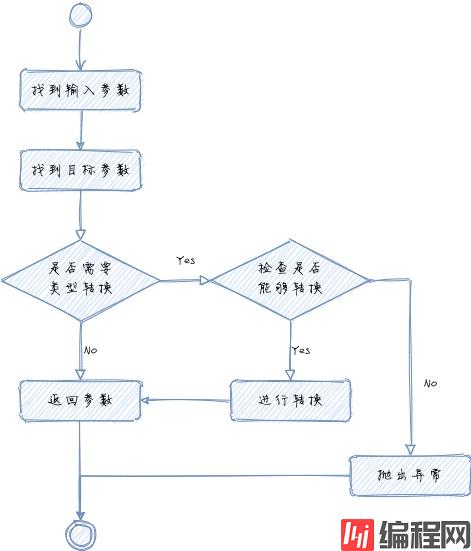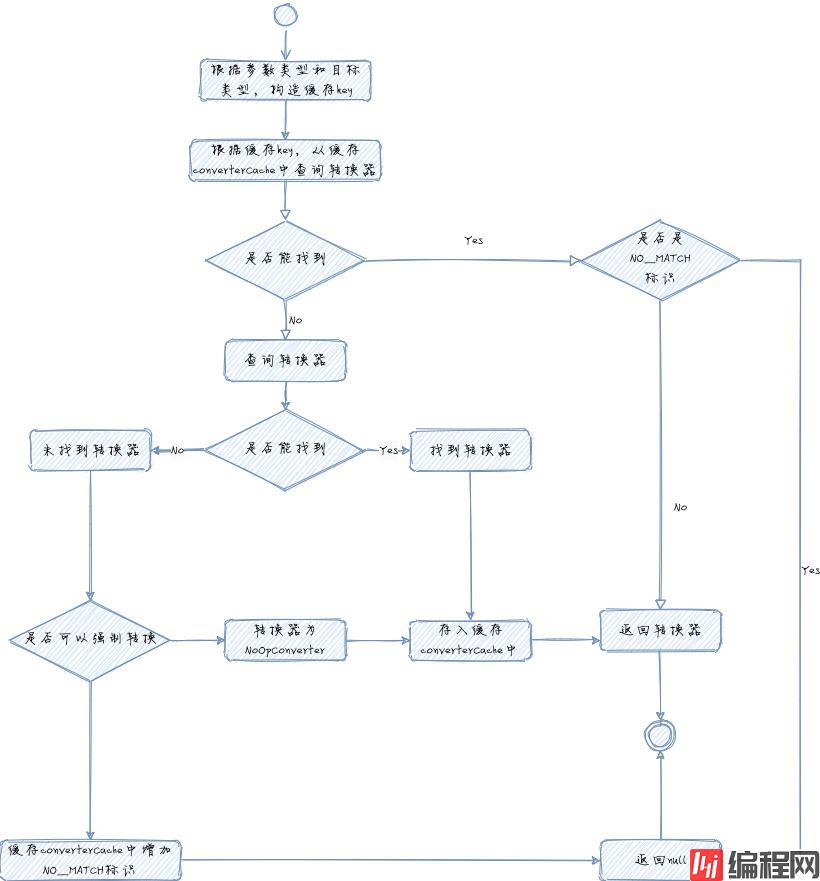Python 官方文档:入门教程 => 点击学习
目录找入口请求入口是DispatcherServlet查找转换器spring 如何查找转换器类型转换跟随源码找到自定义转换器工厂类和转换器类的实现逻辑无论是GET请求,还是传参式的P
所有的请求最终都会落到doDispatch方法中的
ha.handle(processedRequest, response, mappedHandler.getHandler())逻辑。
我们从这里出发,一层一层向里扒。
跟着代码深入,我们会找到
org.springframework.WEB.method.support.InvocableHandlerMethod#invokeForRequest的逻辑:
public Object invokeForRequest(NativeWebRequest request, @Nullable ModelAndViewContainer mavContainer,
Object... providedArgs) throws Exception {
Object[] args = getMethodArgumentValues(request, mavContainer, providedArgs);
if (logger.isTraceEnabled()) {
logger.trace("Arguments: " + Arrays.toString(args));
}
return doInvoke(args);
}
可以看出,这里面通过getMethodArgumentValues方法处理参数,然后调用doInvoke方法获取返回值。
继续深入,能够找到
org.springframework.web.method.annotation.RequestParamMethodArgumentResolver#resolveArgument方法
这个方法就是解析参数的逻辑。
试想一下,如果是我们自己实现这段逻辑,会怎么做呢?

获取输入参数的逻辑在
org.springframework.web.method.annotation.RequestParamMethodArgumentResolver#resolveName
单参数返回的是 String 类型,多参数返回 String 数组。
核心代码如下:
String[] paramValues = request.getParameterValues(name);
if (paramValues != null) {
arg = (paramValues.length == 1 ? paramValues[0] : paramValues);
}
所以说,无论我们的目标参数是什么,输入参数都是 String 类型或 String 数组
在我们的例子中,就是将 String 转换为枚举值。
org.springframework.beans.TypeConverterDelegate#convertIfNecessary方法中
继续深扒找到这么一段逻辑:
if (conversionService.canConvert(sourceTypeDesc, typeDescriptor)) {
try {
return (T) conversionService.convert(newValue, sourceTypeDesc, typeDescriptor);
}
catch (ConversionFailedException ex) {
// fallback to default conversion logic below
conversionAttemptEx = ex;
}
}
这段逻辑中,调用了
org.springframework.core.convert.support.GenericConversionService#canConvert方法
检查是否可转换,如果可以转换,将会执行类型转换逻辑。
检查是否可转换的本质就是检查是否能够找到对应的转换器。
我们可以看看查找转换器的代码
org.springframework.core.convert.support.GenericConversionService#getConverter
可以对我们自己写代码有一些启发:
private final Map<ConverterCacheKey, GenericConverter> converterCache = new ConcurrentReferenceHashMap<>(64);
protected GenericConverter getConverter(TypeDescriptor sourceType, TypeDescriptor targetType) {
ConverterCacheKey key = new ConverterCacheKey(sourceType, targetType);
GenericConverter converter = this.converterCache.get(key);
if (converter != null) {
return (converter != NO_MATCH ? converter : null);
}
converter = this.converters.find(sourceType, targetType);
if (converter == null) {
converter = getDefaultConverter(sourceType, targetType);
}
if (converter != null) {
this.converterCache.put(key, converter);
return converter;
}
this.converterCache.put(key, NO_MATCH);
return null;
}
转换为伪代码就是:

Spring 内部使用Map作为缓存,用来存储通用转换器接口GenericConverter,这个接口会是我们自定义转换器的包装类。
不过,对于 web 请求场景,并发损耗好过阻塞等待。
org.springframework.core.convert.support.GenericConversionService.Converters#find
就是找到对应转换器的核心逻辑:
private final Map<ConvertiblePair, ConvertersForPair> converters = new ConcurrentHashMap<>(256);
@Nullable
public GenericConverter find(TypeDescriptor sourceType, TypeDescriptor targetType) {
// Search the full type hierarchy
List<Class<?>> sourceCandidates = getClasshierarchy(sourceType.getType());
List<Class<?>> targetCandidates = getClassHierarchy(targetType.getType());
for (Class<?> sourceCandidate : sourceCandidates) {
for (Class<?> targetCandidate : targetCandidates) {
ConvertiblePair convertiblePair = new ConvertiblePair(sourceCandidate, targetCandidate);
GenericConverter converter = getReGISteredConverter(sourceType, targetType, convertiblePair);
if (converter != null) {
return converter;
}
}
}
return null;
}
@Nullable
private GenericConverter getRegisteredConverter(TypeDescriptor sourceType,
TypeDescriptor targetType, ConvertiblePair convertiblePair) {
// Check specifically registered converters
ConvertersForPair convertersForPair = this.converters.get(convertiblePair);
if (convertersForPair != null) {
GenericConverter converter = convertersForPair.getConverter(sourceType, targetType);
if (converter != null) {
return converter;
}
}
// Check ConditionalConverters for a dynamic match
for (GenericConverter globalConverter : this.globalConverters) {
if (((ConditionalConverter) globalConverter).matches(sourceType, targetType)) {
return globalConverter;
}
}
return null;
}
我们可以看到,Spring 是通过源类型和目标类型组合起来,查找对应的转换器。
而且,Spring 还通过getClassHierarchy方法,将源类型和目标类型的家族族谱全部列出来,用双层 for 循环遍历查找。
上面的代码中,还有一个matches方法,在这个方法里面,调用了ConverterFactory#getConverter方法
也就是用这个工厂方法,创建了指定类型的转换器。
private final ConverterFactory<Object, Object> converterFactory;
public boolean matches(TypeDescriptor sourceType, TypeDescriptor targetType) {
boolean matches = true;
if (this.converterFactory instanceof ConditionalConverter) {
matches = ((ConditionalConverter) this.converterFactory).matches(sourceType, targetType);
}
if (matches) {
Converter<?, ?> converter = this.converterFactory.getConverter(targetType.getType());
if (converter instanceof ConditionalConverter) {
matches = ((ConditionalConverter) converter).matches(sourceType, targetType);
}
}
return matches;
}
经过上面的逻辑,已经找到判断可以进行转换。
org.springframework.core.convert.support.GenericConversionService#convert
其核心逻辑就是已经找到对应的转换器了,下面就是转换逻辑
public Object convert(@Nullable Object source, @Nullable TypeDescriptor sourceType, TypeDescriptor targetType) {
Assert.notNull(targetType, "Target type to convert to cannot be null");
if (sourceType == null) {
Assert.isTrue(source == null, "Source must be [null] if source type == [null]");
return handleResult(null, targetType, convertNullSource(null, targetType));
}
if (source != null && !sourceType.getObjectType().isInstance(source)) {
throw new IllegalArgumentException("Source to convert from must be an instance of [" +
sourceType + "]; instead it was a [" + source.getClass().getName() + "]");
}
GenericConverter converter = getConverter(sourceType, targetType);
if (converter != null) {
Object result = ConversionUtils.invokeConverter(converter, source, sourceType, targetType);
return handleResult(sourceType, targetType, result);
}
return handleConverterNotFound(source, sourceType, targetType);
}
其中的GenericConverter converter = getConverter(sourceType, targetType)就是前文中getConverter方法。
执行到这里,直接调用
ConversionUtils.invokeConverter(converter, source, sourceType, targetType)转换
其内部是使用
org.springframework.core.convert.support.GenericConversionService.ConverterFactoryAdapter#convert
方法,代码如下:
public Object convert(@Nullable Object source, TypeDescriptor sourceType, TypeDescriptor targetType) {
if (source == null) {
return convertNullSource(sourceType, targetType);
}
return this.converterFactory.getConverter(targetType.getObjectType()).convert(source);
}
这里就是调用ConverterFactory工厂类构建转换器(即IdCodeToEnumConverterFactory类的getConverter方法)
然后调用转换器的conver方法(即IdCodeToEnumConverter类的convert方法),将输入参数转换为目标类型。
具体实现可以看一下实战篇中的代码,这里不做赘述。
至此,我们把整个路程通了下来。
这里需要强调一下的是,由于实战篇中我们用到的例子是简单参数的方式,也就是Controller的方法参数都是直接参数
但是 Http Body 方式却不行,为什么呢?
所以,想要实现 body 的类型转换,还需要走另外一种方式,更多关于Spring对应转换器的枚举参数的资料请关注编程网其它相关文章!
--结束END--
本文标题: SpringBoot实战:Spring如何找到对应转换器优雅使用枚举参数
本文链接: https://www.lsjlt.com/news/133206.html(转载时请注明来源链接)
有问题或投稿请发送至: 邮箱/279061341@qq.com QQ/279061341
下载Word文档到电脑,方便收藏和打印~
2024-03-01
2024-03-01
2024-03-01
2024-02-29
2024-02-29
2024-02-29
2024-02-29
2024-02-29
2024-02-29
2024-02-29
回答
回答
回答
回答
回答
回答
回答
回答
回答
回答
0